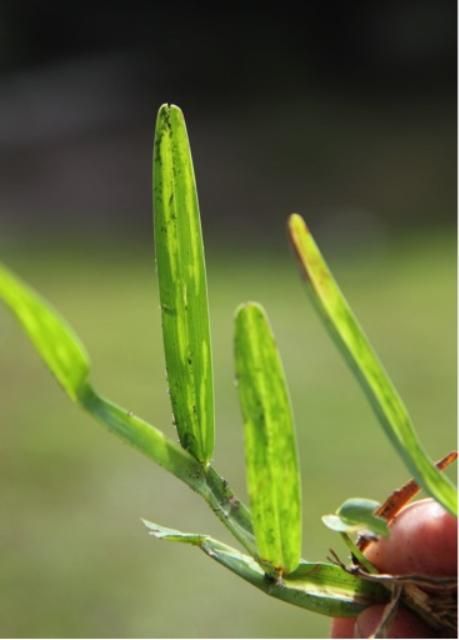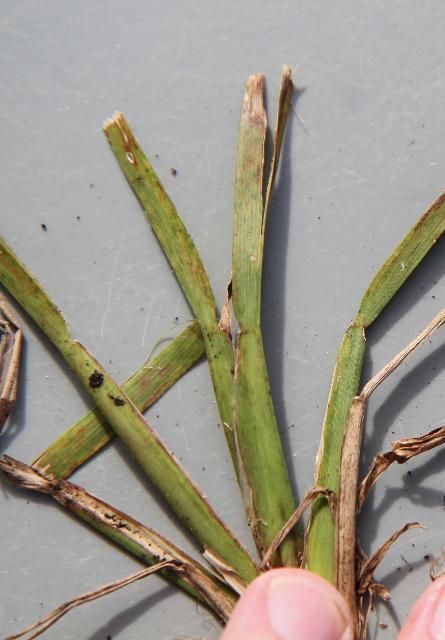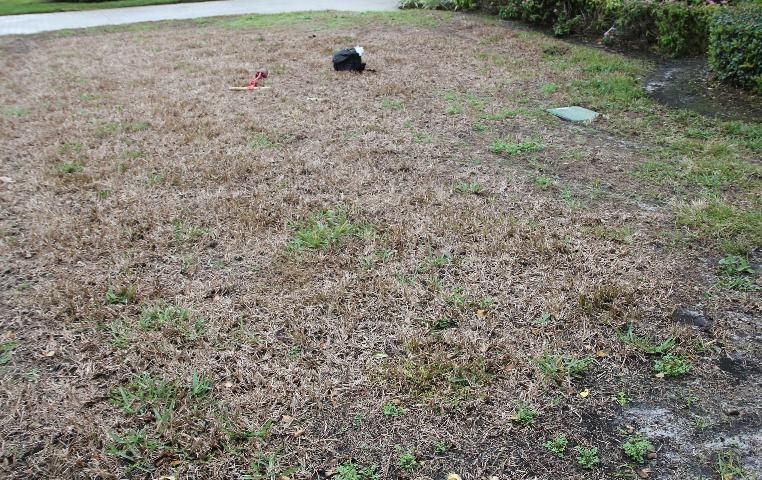History of the Disease on St. Augustinegrass in Florida
Mosaic disease of St. Augustinegrass was first reported in the 1960s in sugarcane producing areas of Florida (rural Palm Beach County). The disease was named for the distinct symptom it produced. Differences in susceptibility among St. Augustinegrass cultivars were noted, and resistance was used to minimize the impact of the disease over the last 50 years. The mildest cases of the disease produce symptoms that are easily overlooked and generally are not cause for concern. Survey efforts in the 1970s did not find the virus in St. Augustinegrass in central or north central Florida. In the 10 years prior to 2013, fewer than five samples with mild symptoms were brought to the attention of the Extension turfgrass pathologist at UF.
Symptoms
Mosaic disease symptoms occur on many plants, presenting as blotchy or streaky patterns of yellow and green color. Grasses showing mosaic symptoms tend to have broken yellow streaks running between veins on an otherwise green blade (Figure 1). Like most plant disease symptoms, mosaic patterns vary among grass varieties and species that they occur on and change appearance as the disease becomes more severe.

In 2013, an outbreak of the disease occurred in Pinellas County, Florida. Leaf symptoms included mosaic, but turned necrotic (Figure 2) and developed into severe dieback that completely killed some infected lawns (Figure 3). The dieback and necrosis started in the fall of the year (September to October) and progressed through spring, when some lawns started to recover. In 2014, the same pattern occurred in two counties. Lawns infected in 2013 and additional lawns started dying in September in both Pinellas and Palm Beach Counties. Symptoms were similar to another viral disease of St. Augustinegrass called St. Augustinegrass decline (SAD, caused by Panicum mosaic virus), but as of November 2014, samples sent to the UF/IFAS Extension Plant Diagnostic Center have tested negative for SAD and positive for presence of Sugarcane Mosaic Virus (SCMV). SAD is not known to occur in Florida.


Causal Agent
SCMV is named for the host where it was first found, sugarcane, but the virus is known to cause disease in several grass species including corn, sorghum, and various other weedy and cultivated grasses. The virus belongs to the potyvirus family and is commonly found in sugarcane-producing areas of the state, although it currently is not a primary concern for sugarcane growers. The virus can change over time and has overcome resistance in sugarcane varieties in the past (CP 72-2086 in the mid-1990s).
Disease Spread
SCMV can be efficiently transmitted by mechanical means. Lawn mowers, line trimmers, and other equipment can transfer clippings and sap containing virus from lawn to lawn. Aphids are known to transmit the virus as well, but it is not known how important aphids or other potential insect vectors are for disease spread. The virus also can be spread on infected sod during the times of year when symptoms are mild and not obvious. Sod with SCMV should not be used.
Management
Plant host resistance is the best management tool for viral diseases. The most severe symptoms in this recent epidemic have been observed on 'Floratam' St. Augustinegrass. 'Floratam' sod used to replace lawns that died from mosaic in 2013 has died again in 2014 in many cases. 'Palmetto' and 'Bitterblue' may get the disease but are more resistant. There are additional considerations and challenges with these cultivars (see https://edis.ifas.ufl.edu/lh010). The susceptibility of most other varieties is currently unknown. The virus has been reported to infect grasses in Cynodon (bermudagrass), Paspalum (seashore paspalum and bahiagrass), Pennisetum (ornamental fountaingrasses), and Stenotaphrum (St. Augustinegrass) genera; however, mosaic is currently only a concern on St. Augustinegrass in Florida. Zoysiagrass is not known to be a host of this virus.
When resodding lawns with mosaic disease, follow UF/IFAS guidelines for post-installation care (https://edis.ifas.ufl.edu/lh013) and choose a variety other than 'Floratam'. Lawns also could be plugged with a less susceptible variety, but it would need to outcompete the 'Floratam' during the spring and summer season.
To minimize disease spread in areas where the virus occurs, mowers and other equipment should be sanitized between properties. The objective is to minimize movement of potentially infected plant material from lawn to lawn, so return clippings where the virus is known to occur rather than removing them from properties. Remove clippings and any other plant material from equipment before moving to another lawn, and then spray down parts of equipment or worker's shoes that have the potential to transfer plant sap using dilute bleach, quaternary ammonia (Green-Shield), alcohol, or another sanitizing agent according to the directions. When mowing multiple lawns where the virus is known to occur, mow apparently healthy lawns before those with mosaic symptoms, and avoid mowing symptomatic lawns when the turfgrass canopy is wet (avoid mowing when dew, irrigation, or rainfall persists).
Fungicides and other pesticides are ineffective and cannot stop development or spread of this viral disease. Also, there are no known agronomic inputs that homeowners or lawn care companies can use to cure a lawn once it has become infected. The disease severity, which ranges from yellowing to death, will vary from lawn to lawn by variety of grass and by other environmental factors not well understood at this time. One potential complicating factor is that lawns with mosaic may also suffer from fungal diseases, but it is not known what impact one disease has on the severity of the others. Managing fungal diseases on lawns with mosaic has not been observed to impact development of the viral disease.
Mosaic is just one of many diseases that may be causing problems on a lawn. To confirm the virus and other diseases, submit a sample to a UF/IFAS Plant Diagnostic Center (https://plantpath.ifas.ufl.edu/extension/plant-diagnostic-center/). Manage other diseases through proper agronomic inputs and practices according to IFAS recommendations for your area. Check the Rapid Turfgrass Diagnostic Service Facebook page (https://www.facebook.com/RapidTurfgrassDiagnosticService) for up-to-date information on the spread of the epidemic.